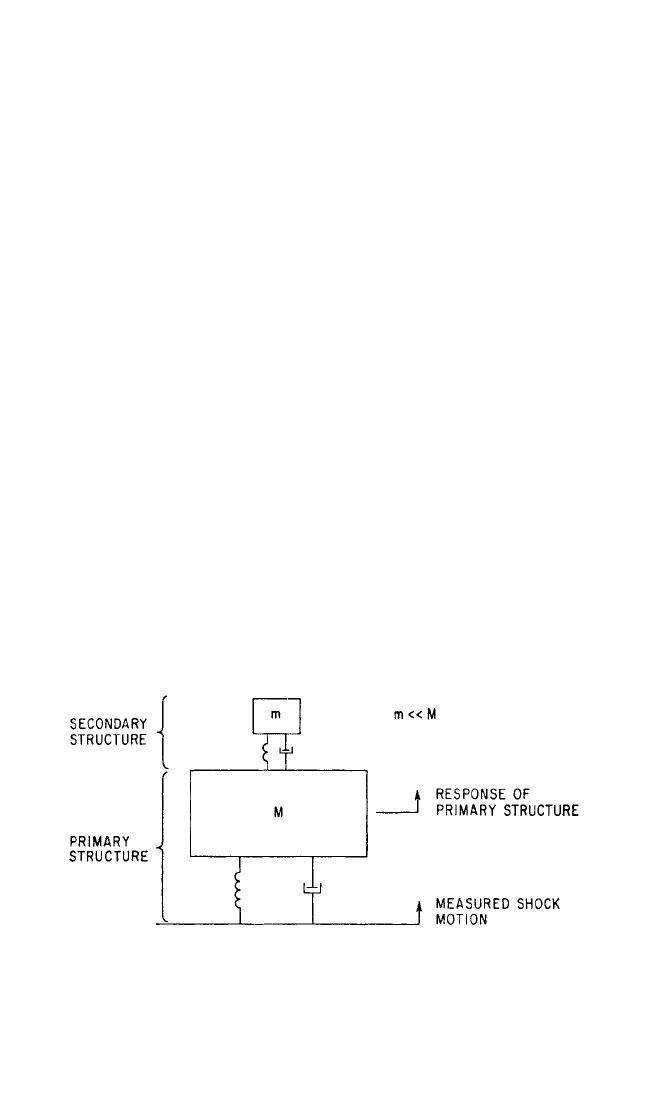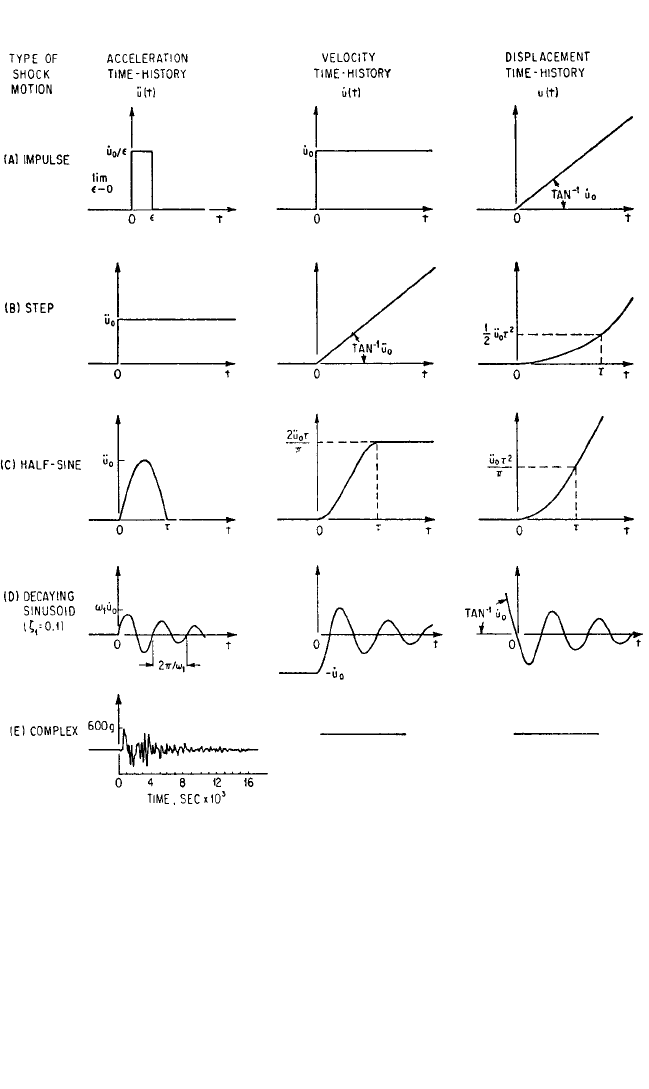Harris C.M., Piersol A.G. Harris Shock and vibration handbook
Подождите немного. Документ загружается.


22.25
TABLE 22.5 Summary of Algorithms for Nonstationary Vibration Data Analysis
Function Analog equation Digital algorithm
Mean value
ˆ
µ
x
(t) =
t + T/2
t − T/2
x(τ)dτ
ˆ
µ
x
(k∆t) =
k + N/2
n = k − N/2
x(n∆t)
Mean-square value
ˆ
ψ
2
x
(t) =
t + T/2
t − T/2
x
2
(τ)dτ
ˆ
ψ
2
x
(k∆t) =
k + N/2
n = k − N/2
x
2
(n∆t)
Variance
ˆ
σ
2
x
(t) =
t + T/2
t − T/2
[x(τ) −
ˆ
µ
x
]
2
dτ
ˆ
σ
2
x
(k∆t) =
k + N/2
n = k − N/2
[x(n∆t) −
ˆ
µ
x
]
2
Instantaneous line
ˆ
L
x
(f,t
i
) = |X
i
(f,T )|; f > 0;
ˆ
L
x
(m∆f,t
i
) = |X(m∆f,t
i
)|;
spectrum via FFT
i = 1,2,3,...;and m = 1,2,...,[(N/2) − 1] and
for deterministic
X
i
(f,T ) computed over t
i
T/2 X(m∆f,t
i
) computed over t
i
(N
i
∆t/2)
data*
Instantaneous
ˆ
W
xx
(f
k
,t
i
) =
t
i
+ T
i
/2
t
i
− T
i
/2
x
2
(f
k
,B
k
,τ)dτ;
ˆ
W
xx
(f
k
,n
i
∆t) =
n
i
+ (N
i
/2)
n = n
i
− (N
i
/2)
x
2
(f
k
,B
k
,n∆t);
power spectrum via
i = 1,2,3,...,and k = 1,2,3,... i = 1,2,3,...,and k = 1,2,3,...
bandpass filtering
for random data
* X(f,T) defined in Eq. (22.3), X(m∆f) defined in Eq. (22.26).
1
B
k
N
i
∆t
1
B
k
T
i
2
N
i
∆t
2
T
1
N − 1
1
T
1
N
1
T
1
N
1
T
8434_Harris_22_b.qxd 09/20/2001 12:06 PM Page 22.25

1. Compute a running average for the overall value of interest using either Eq.
(22.34) or (22.35) with an averaging time, T = N∆t, that is too short to smooth out
the variations with time in the overall value being estimated.
2. Continuously recompute the running average with an increasing averaging time
until it is clear that the averaging time is smoothing out variations with time in the
overall value being estimated.
3. Choose that averaging time for the analysis that is just short of the averaging time
that clearly smoothes out variations with time in the overall value being estimated.
This procedure is illustrated in Fig. 22.9, which shows running average estimates for
the time-varying mean-square value of a nonstationary random vibration record
computed with averaging times of T = 0.1, 1.0, and 3.0 sec. Note that the running
average estimates with T = 0.1 sec reveal substantial random variations from one
estimate to the next, indicative of excessive random estimation errors, while the esti-
mates with T = 3 sec reveal a clear smoothing of the nonstationary trend in the data,
indicative of an excessive time interval bias error. The averaging time of T = 1 sec
provides a good compromise between the suppression of random and bias errors in
the data analysis.
Instantaneous Line Spectrum for Deterministic Data. Again referring to Table
22.5, the most common way to analyze the spectral characteristics of nonstationary
deterministic vibration data is to estimate the instantaneous line spectrum defined in
Eq. (22.19) by a sequence of line spectra computed over the time intervals defined in
Eq. (22.34) or (22.35). The resulting collection of line spectra is commonly referred to
as a waterfall plot or a cascade plot. An illustration of a waterfall plot computed from
a sample record of nonstationary deterministic vibration data is shown in Fig. 14.25.
For a spectral analysis using Fourier transforms, the averaging time T = N∆t and
the frequency resolution ∆f = 1/T = 1/(N∆t) are obviously interrelated. It follows that
there must always be a compromise between these two analysis parameters. On the
22.26 CHAPTER TWENTY-TWO
FIGURE 22.9 Running mean-square value estimates for nonstationary vibration data.
8434_Harris_22_b.qxd 09/20/2001 12:06 PM Page 22.26

one hand, the averaging time must be longer than the period of the lowest instanta-
neous frequency component in the data at any time covered by the sample record.
On the other hand, the frequency resolution must be narrower than the minimum
frequency separation of any two instantaneous frequency components in the data at
any time covered by the sample record. This compromise will generally be achiev-
able for nonstationary deterministic vibration data that would be periodic if they
were stationary. In this case, assuming the maximum period at any time covered by
the sample record is T
P
, it follows that ∆f < 1/T
P
if T > T
P
. However, for almost-
periodic deterministic vibration data, there may be two spectral components that, at
some instant, might be separated by less than ∆f = 1/T where T > T
1
. See Chap. 14 for
further details on the computation of waterfall plots and other procedures for the
analysis of nonstationary deterministic vibration data.
Instantaneous Power Spectra for Random Data. Referring to Table 22.5, the
instantaneous power spectrum for nonstationary random vibration data requires an
averaging operation to suppress the statistical sampling errors associated with all
random data analysis, as suggested by the expected value operation in Eq. (22.21).
This averaging operation can be accomplished in several ways. For example, the
sample record could be divided into a sequence of contiguous time intervals of
appropriate durations and a power spectrum for the data in each time interval com-
puted using the ensemble-averaging procedure detailed in Table 22.3. However, the
most straightforward way is to compute the instantaneous power spectrum using the
bandpass filtering approach in Fig. 22.5, and computing a running average of the
squared output of each bandpass filter centered at frequency f
i
with an averaging
time of T
i
= N
i
∆t; i = 1,2,3,...,as shown in Table 22.5. For reasons to be discussed
shortly, a fixed averaging time of T = N∆t commonly can be used for all frequency
bands with good results.
A straightforward but time-consuming way to select an appropriate averaging time
for an instantaneous power spectrum estimate with bandpass digital filters is to use the
trial-and-error procedure illustrated for nonstationary mean-square value estimates in
Fig. 22.9, except now the optimum averaging time would have to be determined sepa-
rately for each frequency resolution bandwidth B
i
. On the other hand, the problem
can also be approached analytically by determining the averaging time and resolution
bandwidth that will minimize the total mean-square error in the estimate, similar to
the procedure given in Eqs. (22.31) through (22.33) for stationary random vibration
data. In this case, however, there is a third error that must be included in the total
mean-square error, namely, a time resolution bias error caused by smoothing through
the time-varying values of the instantaneous power spectrum. A maximum value for
the normalized time resolution bias error can be approximated by
1
ε
bt
[
ˆ
W
xx
(f)] =
2
(22.36)
where T
Di
is the half-power point duration about the maximum power-spectral den-
sity value in the ith resolution bandwidth, that is, the time interval between the time
t
1
before and the time t
2
after that time t
m
when the maximum value occurs such that
W
xx
(f
i
,t
1
) = W
xx
(f
i
,t
2
) = W
xx
(f
i
,t
m
)/2. Ideally, this time duration should be determined
individually for each frequency resolution bandwidth, but it will often suffice to use
a single value for T
D
determined from the estimate for the time-varying mean-
square value of the data, as illustrated in Fig. 22.9.Adding Eq. (22.36) with a constant
value T
D
to Eq. (22.32), taking partial derivatives with respect to T and B
e
, equating
to zero, and solving the two simultaneous equations, yields the optimum averaging
time and resolution bandwidth as
1
2π
3T
Di
T
i
2
24
CONCEPTS IN VIBRATION DATA ANALYSIS 22.27
8434_Harris_22_b.qxd 09/20/2001 12:06 PM Page 22.27

T
0
(f) = 1.31 T
D
5/6
/(ζf)
1/6
B
0
(f) = 1.94(ζf)
5/6
/T
D
1/6
(22.37)
Note in Eq. (22.37) that the averaging time T
0
(f) is a function of the −
1
⁄6 power of the
product ζf, while the resolution bandwidth B
0
(f) is a function of the
5
⁄6 power of the
product ζf. Assuming all structural resonances have approximately the same damp-
ing ratio, this means a fixed averaging time and a constant percentage resolution
bandwidth will provide near-optimum results in terms of a minimum mean-square
error in the instantaneous power-spectrum estimate. For example, assume the meas-
ured vibration response of a structure exposed to a nonstationary random excitation
has a time-varying mean-square value similar to that shown in Fig. 22.9, where the
half-power duration is about T
D
≈ 2.5 sec. Further assume all resonant modes of the
structure have a damping ratio of ζ=0.05. From Eq. (22.37), the optimum averaging
time for the computation of an instantaneous power spectrum of the nonstationary
structural vibration is T
0
(f) = 4.63f
−1/6
, while the optimum resolution bandwidth is
B
0
(f) = 0.137f
5/6
. Hence, if the frequency range of the analysis is, say, 10 Hz to 1000
Hz, the optimum averaging time for the analysis decreases from T
0
= 3.15 sec at 10
Hz to T
0
= 1.46 sec at 1000 Hz, while the optimum resolution bandwidth increases
from B
0
= 0.933 Hz at f = 10 Hz [B
0
(f) = 0.0933f] to B
0
= 43.3 Hz at f = 1000 Hz
[B
0
(f) = 0.0433f]. It follows that an analysis with a fixed averaging time of about T =
2.5 sec and a constant percentage resolution bandwidth of
1
⁄12 octave, which is equiv-
alent to B
e
(f) = 0.058f, will provide relative good instantaneous spectral estimates
over the entire frequency range of interest. See Ref. 1 for details on specialized pro-
cedures for analyzing special cases of nonstationary random vibration data.
REFERENCES
1. Bendat, J. S., and A. G. Piersol:“Random Data:Analysis and Measurement Procedures,” 3d
ed., John Wiley & Sons, Inc., New York, 2000.
2. Himelblau, H., et al.: “Handbook for Dynamic Data Acquisition and Analysis,” IEST Rec-
ommended Practice DTE012.1, Institute of Environmental Sciences and Technology,
Mount Prospect, Ill., 1994.
3. Bendat, J. S.: “Nonlinear Systems Techniques and Applications,” John Wiley & Sons, Inc.,
New York, 1998.
4. Wirching, P. H., T. L. Paez, and H. Ortiz: “Random Vibrations, Theory and Practice,” John
Wiley & Sons, Inc., New York, 1995.
5. Nigam, N. C.:“Introduction to Random Vibrations,” MIT Press, Cambridge, Mass., 1983.
6. Newland, D. E.: “Random Vibrations, Spectral Analysis and Wavelet Analysis,” 3d ed.,
Longman, Essex, England, 1993.
7. Bendat, J. S., and A. G. Piersol: “Engineering Applications of Correlation and Spectral
Analysis,” 2d ed., John Wiley & Sons, Inc., New York, 1993.
8. Gardner, W. A.: “Cyclostationarity in Communications and Signal Processing,” IEEE
Press, New York, 1994.
9. Cohen, L.: “Time-Frequency Analysis,” Prentice-Hall, Inc., Upper Saddle River, N.J., 1995.
10. Schmidt, H.: J. Sound and Vibration, 101(3):347 (1985).
22.28 CHAPTER TWENTY-TWO
8434_Harris_22_b.qxd 09/20/2001 12:06 PM Page 22.28

CHAPTER 23
CONCEPTS IN
SHOCK DATA ANALYSIS
Sheldon Rubin
INTRODUCTION
This chapter discusses the interpretation of shock measurements and the reduction
of data to a form adapted to further engineering use. Methods of data reduction also
are discussed.A shock measurement is a trace giving the value of a shock parameter
versus time over the duration of the shock, referred to hereafter as a time-history.
The shock parameter may define a motion (such as displacement, velocity, or accel-
eration) or a load (such as force, pressure, stress, or torque). It is assumed that any
corrections that should be applied to eliminate distortions resulting from the instru-
mentation have been made.The trace may be a pulse or transient. Concepts in vibra-
tion data analysis are discussed in Chap. 22.
Examples of sources of shock to which this discussion applies are earthquakes
(see Chap. 24), free-fall impacts, collisions, explosions, gunfire, projectile impacts,
high-speed fluid entry, aircraft landing and braking loads, and spacecraft launch and
staging loads.
BASIC CONSIDERATIONS
Often, a shock measurement in the form of a time-history of a motion or loading
parameter is not useful directly for engineering purposes. Reduction to a different
form is then necessary, the type of data reduction employed depending upon the
ultimate use of the data.
Comparison of Measured Results with Theoretical Prediction. The correlation
of experimentally determined and theoretically predicted results by comparison of
records of time-histories is difficult. Generally, it is impractical in theoretical analy-
ses to give consideration to all the effects which may influence the experimentally
obtained results. For example, the measured shock often includes the vibrational
response of the structure to which the shock-measuring device is attached. Such
vibration obscures the determination of the shock input for which an applicable the-
ory is being tested; thus, data reduction is useful in minimizing or eliminating the
23.1
8434_Harris_23_b.qxd 09/20/2001 12:02 PM Page 23.1

irrelevancies of the measured data to permit ready comparison of theory with cor-
responding aspects of the experiment. It often is impossible to make such compar-
isons on the basis of original time-histories.
Calculation of Structural Response. In the design of equipment to withstand
shock, the required strength of the equipment is indicated by its response to the
shock. The response may be measured in terms of the deflection of a member of the
equipment relative to another member or by the magnitude of the dynamic loads
imposed upon the equipment. The structural response can be calculated from the
time-history by known means; however, certain techniques of data reduction result
in descriptions of the shock that are related directly to structural response.
As a design procedure it is convenient to represent the equipment by an appro-
priate model that is better adapted to analysis (see Chap. 41). A typical model is
shown in Fig. 23.1; it consists of a secondary structure supported by a primary
structure. Each structure is represented as a lumped-parameter single degree-of-
freedom system with the secondary mass m much smaller than the primary mass M
so that the response of the primary mass is unaffected by the response of the sec-
ondary mass. The response of the primary mass to an input shock motion is the
input shock motion to the secondary structure. Depending upon the ultimate
objective of the design work, certain characteristics of the response of the model
must be known:
1. If design of the secondary structure is to be effected, it is necessary to know the
time-history of the motion of the primary structure. Such motion constitutes the
excitation for the secondary structure.
2. In the design of the primary structure, it is necessary to know the deflection of
such structure as a result of the shock, either the time-history or the maximum
value.
By selection of suitable data reduction methods, response information useful in
the design of the equipment is obtained from the original time-history.
23.2 CHAPTER TWENTY-THREE
FIGURE 23.1 Commonly used structural model consisting of a primary and a
secondary structure.
Laboratory Simulation of Measured Shock. Because of the difficulty of using
analytical methods in the design of equipment to withstand shock, it is common
practice to prove the design of equipments by laboratory tests that simulate the
anticipated actual shock conditions. Unless the shock can be defined by one of a
8434_Harris_23_b.qxd 09/20/2001 12:02 PM Page 23.2

few simple functions, it is not feasible to reproduce in the laboratory the complete
time-history of the actual shock experienced in service. Instead, the objective is to
synthesize a shock having the characteristics and severity considered significant in
causing damage to equipment. Then, the data reduction method is selected so that
it extracts from the original time-history the parameters that are useful in specify-
ing an appropriate laboratory shock test. Shock testing machines are discussed in
Chap. 26.
EXAMPLES OF SHOCK MOTIONS
Five examples of shock motions are illustrated in Fig. 23.2 to show typical character-
istics and to aid in the comparison of the various techniques of data reduction. The
acceleration impulse and the acceleration step are the classical limiting cases of
shock motions. The half-sine pulse of acceleration, the decaying sinusoidal accelera-
tion, and the complex oscillatory-type motion typify shock motions encountered fre-
quently in practice.
In selecting data reduction methods to be used in a particular circumstance, the
applicable physical conditions must be considered. The original record, usually a
time-history, may indicate any of several physical parameters; e.g., acceleration,
force, velocity, or pressure. Data reduction methods discussed in subsequent sections
of this chapter are applicable to a time-history of any parameter. For purposes of
illustration in the following examples, the primary time-history is that of accelera-
tion; time-histories of velocity and displacement are derived therefrom by integra-
tion. These examples are included to show characteristic features of typical shock
motions and to demonstrate data reduction methods.
ACCELERATION IMPULSE OR STEP VELOCITY
The delta function d(t) is defined mathematically as a function consisting of an infi-
nite ordinate (acceleration) occurring in a vanishingly small interval of abscissa
(time) at time t = 0 such that the area under the curve is unity. An acceleration time-
history of this form is shown diagrammatically in Fig. 23.2A. If the velocity and dis-
placement are zero at time t = 0, the corresponding velocity time-history is the
velocity step and the corresponding displacement time-history is a line of constant
slope, as shown in the figure. The mathematical expressions describing these time
histories are
ü(t) = ˙u
0
d(t) (23.1)
where d(t) = 0 when t ≠ 0, d(t) =∞when t = 0, and
∞
−∞
d(t) dt = 1. The acceleration can
be expressed alternatively as
ü(t) = lim
→ 0
˙u
0
/ [0 < t < ] (23.2)
where ü(t) = 0 when t < 0 and t > . The corresponding expressions for velocity and
displacement for the initial conditions u = ˙u = 0 when t < 0 are
˙u(t) = ˙u
0
[t > 0] (23.3)
u(t) = ˙u
0
t [t > 0] (23.4)
CONCEPTS IN SHOCK DATA ANALYSIS 23.3
8434_Harris_23_b.qxd 09/20/2001 12:02 PM Page 23.3

ACCELERATION STEP
The unit step function 1(t) is defined mathematically as a function which has a value
of zero at time less than zero (t < 0) and a value of unity at time greater than zero
(t > 0). The mathematical expression describing the acceleration step is
ü(t) = ü
0
1(t) (23.5)
23.4 CHAPTER TWENTY-THREE
FIGURE 23.2 Five examples of shock motions.
8434_Harris_23_b.qxd 09/20/2001 12:02 PM Page 23.4

where 1(t) = 1 for t > 0 and 1(t) = 0 for t < 0. An acceleration time-history of the unit
step function is shown in Fig. 23.2B; the corresponding velocity and displacement
time-histories are also shown for the initial conditions u = ˙u = 0 when t = 0.
˙u(t) = ü
0
t [t > 0] (23.6)
u(t) =
1
⁄2ü
0
t
2
[t > 0] (23.7)
The unit step function is the time integral of the delta function:
1(t) =
t
−∞
d(t) dt [t > 0] (23.8)
HALF-SINE ACCELERATION
A half-sine pulse of acceleration of duration τ is shown in Fig. 23.2C; the correspon-
ding velocity and displacement time-histories also are shown, for the initial condi-
tions u = ˙u = 0 when t = 0. The applicable mathematical expressions are
ü(t) = ü
0
sin
[0 < t <τ]
ü(t) = 0 when t < 0 and t >τ
(23.9)
˙u(t) =
1 − cos
[0 < t <τ]
˙u(t) = [t >τ]
(23.10)
u(t) =
− sin
[0 < t <τ]
u(t) =
− 1
[t >τ]
(23.11)
This example is typical of a class of shock motions in the form of acceleration pulses
not having infinite slopes.
DECAYING SINUSOIDAL ACCELERATION
A decaying sinusoidal trace of acceleration is shown in Fig. 23.2D; the corresponding
time-histories of velocity and displacement also are shown for the initial conditions
u˙ =−˙u
0
and u = 0 when t = 0. The applicable mathematical expression is
ü(t) = e
−ζ
1
ω
1
t
sin (1
−
ζ
1
2
ω
1
t + sin
−1
(2ζ
1
1
−
ζ
1
2
)) [t > 0] (23.12)
where ω
1
is the frequency of the vibration and ζ
1
is the fraction of critical damping
corresponding to the decrement of the decay. Corresponding expressions for veloc-
ity and displacement are
˙u
0
ω
1
1
−
ζ
1
2
2t
τ
ü
0
τ
2
π
πt
τ
πt
τ
ü
0
τ
2
π
2
2ü
0
τ
π
πt
τ
ü
0
τ
π
πt
τ
CONCEPTS IN SHOCK DATA ANALYSIS 23.5
8434_Harris_23_b.qxd 09/20/2001 12:02 PM Page 23.5

˙u(t) = e
−ζ
1
ω
1
t
cos (1
−
ζ
1
2
ω
1
t + sin
−1
ζ
1
)[t > 0] (23.13)
where ˙u(t) =−˙u
0
when t < 0.
u(t) =− e
−ζ
1
ω
1
t
sin (1
−
ζ
1
2
ω
1
t)[t > 0] (23.14)
where u(t) =−˙u
0
t when t < 0.
COMPLEX SHOCK MOTION
The trace shown in Fig. 23.2E is an acceleration time-history representing typical
field data. It cannot be defined by an analytic function. Consequently, the corre-
sponding velocity and displacement time-histories can be obtained only by numeri-
cal, graphical, or analog integration of the acceleration time-history.
CONCEPTS OF DATA REDUCTION
Consideration of the engineering uses of shock measurements indicates two basically
different methods for describing a shock: (1) a description of the shock in terms of its
inherent properties, in the time domain or in the frequency domain; and (2) a descrip-
tion of the shock in terms of the effect on structures when the shock acts as the exci-
tation. The latter is designated reduction to the response domain. The following
sections discuss concepts of data reduction to the frequency and response domains.
Whenever practical, the original time-history should be retained even though the
information included therein is reduced to another form. The purpose of data reduc-
tion is to make the data more useful for some particular application. The reduced
data usually have a more limited range of applicability than the original time-history.
These limitations must be borne in mind if the data are to be applied intelligently.
DATA REDUCTION TO THE FREQUENCY DOMAIN
Any nonperiodic function can be represented as the superposition of sinusoidal
components, each with its characteristic amplitude and phase.
1
This superposition is
the Fourier spectrum, as defined in Eq. (23.55). It is analogous to the Fourier com-
ponents of a periodic function (Chap. 22). The Fourier components of a periodic
function occur at discrete frequencies, and the composite function is obtained by
superposition of components. By contrast, the classical Fourier spectrum for a non-
periodic function is a continuous function of frequency, and the composite function
is achieved by integration. The following sections discuss the application of the con-
tinuous Fourier spectrum to describe the shock motions illustrated in Fig. 23.2. A dis-
crete realization of the Fourier spectrum is given by Eq. (22.26).
Acceleration Impulse. Using the definition of the acceleration pulse given by Eq.
(23.2) and substituting this for f(t) in Eq. (23.55),
F(ω) = lim
→ 0
0
e
−jωt
dt (23.15)
˙u
0
˙u
0
ω
1
1
−
ζ
1
2
˙u
0
1
−
ζ
1
2
23.6 CHAPTER TWENTY-THREE
8434_Harris_23_b.qxd 09/20/2001 12:02 PM Page 23.6
